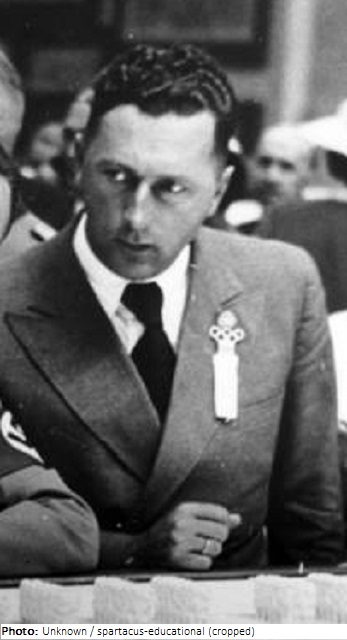
| Roles | Referee |
|---|---|
| Sex | Male |
| Full name | Hans Herbert•Schweitzer |
| Used name | Hans•Schweitzer |
| Other names | Mjölnir |
| Born | 25 July 1901 in Berlin, Berlin (GER) |
| Died | 15 September 1980 (aged 79 years 1 month 21 days) in Landstuhl, Rheinland-Pfalz (GER) |
| NOC |  Germany Germany |
As an illegitimate son of a doctor, Hans Schweitzer grew up with his grandmother. In his youth, he joined the “Freikorps” after the end of World War I. In 1918-23, he studied at the Academy of Fine Arts in Berlin. He then worked as a press artist and political cartoonist for the national-conservative Hugenberg group. In 1924 he designed the so-called “Stab-in-the-back” election poster of the German National People’s Party, which was intended to blame the defeat in World War I on the German Social Democrats.
In 1926, Schweitzer became a member of the National Socialist Party (NSDAP) and choose as a pseudonym the name Mjölnir, which denotes the war hammer of the god Thor in Nordic mythology. He was a regular contributor to various Nazi publications and designed other propaganda material. As a supporter of the social-revolutionary wing of the NSDAP, he left the party in 1930, but shortly thereafter was persuaded by the Berlin Gauleiter and later Propaganda Minister Goebbels to continue his collaboration. In 1932, he designed the highly successful election poster with the slogan “Our last hope: Hitler”.
After the Nazis came to power, Schweitzer was appointed “Draftsman of the Movement” in 1933 and became Reich Commissioner for Artistic Design in 1935. In this capacity, he designed coins, banknotes, and postage stamps of the German Reich. In 1936, he was appointed member of the Presidential Council of the Reich Chamber of Fine Arts and professor the following year. He was also a member of the commission for the confiscation of “degenerate art”. During World War II, he organized art exhibitions and became a draftsman for a propaganda company as an SS-Oberführer.
After the end of the war, Schweitzer was interned in the former Neuengamme concentration camp and fined 500 marks in 1948 in the frame of denazification. He then continued to work as an illustrator for conservative and right-wing publications, but also as a poster designer for splinter parties and even for the Press and Information Office of the federal government.
Schweitzer/Mjölnir is considered one of the most important Nazi propaganda illustrators. However, he did not limit his work to the field of anti-Semitic caricature. In the design of posters, illustrations, and book decorations, he used naturalistic-expressive, sometimes drastic-violent, and mostly pathetic-heroic depictions of workers, SA men, or soldiers, consciously adopting stylistic devices of Expressionist art and contemporary Socialist propaganda.
| Games | Sport (Discipline) / Event | NOC / Team | Phase | Unit | Role | As | |
|---|---|---|---|---|---|---|---|
| 1936 Summer Olympics | Art Competitions |  GER GER |
Hans Schweitzer | ||||
| Architecture, Designs For Town Planning, Open (Olympic) | Final Standings | Judge | |||||
| Architecture, Architectural Designs, Open (Olympic) | Final Standings | Judge | |||||
| Painting, Applied Arts, Open (Olympic) | Final Standings | Judge | |||||
| Painting, Paintings, Open (Olympic) | Final Standings | Judge | |||||
| Painting, Graphic Arts, Open (Olympic) | Final Standings | Judge | |||||
| Painting, Drawings And Water Colors, Open (Olympic) | Final Standings | Judge | |||||
| Sculpturing, Medals, Open (Olympic) | Final Standings | Judge | |||||
| Sculpturing, Reliefs, Open (Olympic) | Final Standings | Judge | |||||
| Sculpturing, Statues, Open (Olympic) | Final Standings | Judge |